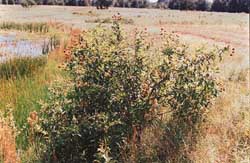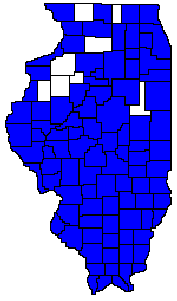 |
| Buttonbush (Cephalanthus occidentalis) Distribution
Map to Right |

Shape
and Distribution
Buttonbush
is a shrub, typically less than 10 feet tall. It requires wet soils and
is occurs along swamps, small ponds, and streams throughout the eastern
half of the United States. In Illinois, it is common along streams and
is present around the swamps in extreme southern Illinois.
Interesting
Facts
Buttonbush
is the only truly aquatic shrub in central Illinois. It takes its common
name from the fact that the flowers, which are clustered together in ball-shaped
structures at the ends of twigs, look like buttons. The wilted leaves reportedly
can poison livestock.
Identifying Features
Leaves
Buttonbush typically has opposite, but sometimes whorled leaves in groups of 3 or 4 leaves. Leaves are up to 3 - 6 inches long, and lance-shaped with a pointed tip. The leafstalks are red and the twigs are rounded and smooth.
Flowers
The flowers are white, tubular, and clustered into rounded heads at the ends of the twigs.
Uses
The Fox
(Mesqwaki) people used a concoction made from the inner bark as an emetic.
It was considered a very important medicine. Early European settlers used
the bark as a substitute for quinine to treat malaria. Malaria was actually
quite common in areas around the wet depressions on prairies and along
the big rivers in Illinois.